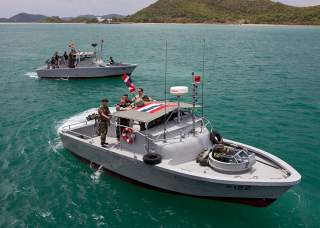Southeast Asia's Armies Outpace Naval Expansion
Thailand, Indonesia and Myanmar have three of Southeast Asia’s largest militaries. They are also countries in which the dominance of the army has likely diminished the navy’s growth prospects.
With Southeast Asian nations facing a deteriorating external security environment and increasing Chinese maritime assertiveness, many commentators have predicted a widespread naval expansion in the region. Yet to date these predictions have fallen short. Instead, there has been a stagnation in Southeast Asian naval development. This can, with some irony, be explained by examining the region’s armies.
While there have been some capability increases across Southeast Asian navies, such as in submarines, most of the growth has been isolated to smaller classes such as patrol boats and fast attack craft. The number of larger offshore surface combatants — like frigates — have fallen across the board. In personnel terms, Southeast Asian navies remain proportionally small — on average about a fifth of the size of their army brethren. By contrast, Western navies are on average close to half the size of their land force counterparts.
These facts don’t deny that Southeast Asian navies are improving their capabilities in niche areas. But overall there is no significant evidence that Southeast Asia’s navies are expanding. Why is this? One possible explanation is that these countries are free-riding on the United States’ security guarantee. But there are also significant internal factors at play.
While Southeast Asia is a maritime region in geographical terms, history has led to a bias in the region’s militaries towards the land forces. And governments have had little power to change this. According to Croissant, Chambers and Volkel, civil control of the military is only assured in one country, Singapore. This means that scenarios of institutionalised army dominance and weak civil control of the military are common across Southeast Asia. Governments are unwilling or unable to reallocate funding away from armies to maritime forces.
Thailand, Indonesia and Myanmar have three of Southeast Asia’s largest militaries. They are also countries in which the dominance of the army has likely diminished the navy’s growth prospects. Data from the Stockholm International Peace Research Institute’s arms trade database from 1950 to 2015 show no consistent growth in their navies’ share of defence imports. Because Southeast Asian countries lack indigenous defence industry, share of imports is a good indication of defence spending priorities.
In both Thailand and Indonesia, military decisions during early statehood set their armies on a path to prominence. While attempting to deter colonial powers, Thailand embarked on a significant expansion of its army through introducing conscription and building a 10-division land force. Similarly, Indonesia defeated its erstwhile Dutch colonisers through implementing an army-led territorial strategy so successful it determined the structure of the Indonesian National Armed Forces. On the other hand, Myanmar’s cohesive indigenous army was developed while the country was under Japanese occupation in World War II.
In all three countries, subsequent key political events accelerated and accentuated their armies’ dominance. In Thailand, the 1932 Revolution fostered an unstable political environment and led leaders to build up the army as a power base by directing resources towards expansion and rewarding supporters. In Indonesia, the ascent of the New Order regime in 1965 deeply entrenched the territorially structured National Armed Forces as a system of political control, and as a revenue raising method. And in Myanmar, difficulties in quelling ethnic separatism saw the army seize power in 1962.
Over the course of decades, army prominence has become army dominance. In both Thailand and Myanmar, the growth of their armies’ political power has rendered their positions virtually impregnable. Army officers dominate key positions in defence ministries, and the armies control and consume most of the military budget. Elected governments are not strong enough to transform this situation. In Indonesia, for instance, the territorial system continues to provide the Indonesian army with political influence throughout the archipelago and at the national level, regardless of its formal withdrawal from politics. Its power has barely been dented by the consolidation of Indonesia’s democratic processes.
Southeast Asia’s army dominance means that navy development, if it is to occur at all, cannot be at the expense of the army. Goldrick and McCaffrie admit that ‘short of extraordinary changes in a country’s security position’, navies will receive only their fixed share of resources. While this share will allow Southeast Asian navies niche modernisation, it seems unlikely to furnish significant expansion unless both economic growth and high defence spending return to the levels of the 1990s. But with the current state of global growth, this seems unlikely.
This means that policymakers must be cautious when assessing the prospects of declared navy expansion programs. In the mid-1990s, Thailand announced plans for a significant regional navy, but in 2015 the Thai navy had fewer personnel, fewer frigates, no submarines, and an aircraft carrier that rarely went to sea. Indonesia’s Global Maritime Fulcrum policy promised a larger green water navy, but programming challenges alone have caused huge delays in the project.
There are broader implications here. Without a strategic shock, Southeast Asian nations won’t develop substantial capacities for sea denial, let alone sea control or force projection, any time soon. While that will be stabilising locally, further afield it suggests that the burden of balancing China will continue to be borne by the navies of Japan, the United States and possibly India.
Greg Raymond is a Research Fellow at the Strategic and Defence Studies Centre, The Australian National University.
This article is based on a longer paper, Naval Modernization in Southeast Asia: Under the Shadow of Army Dominance?, available in the April 2017 volume of Contemporary Southeast Asia.
This article originally appeared at East Asia Forum here.
Image: Riverine Warfare demonstration aboard Thai riverine patrol boats. Wikimedia Commons/U.S. Navy

